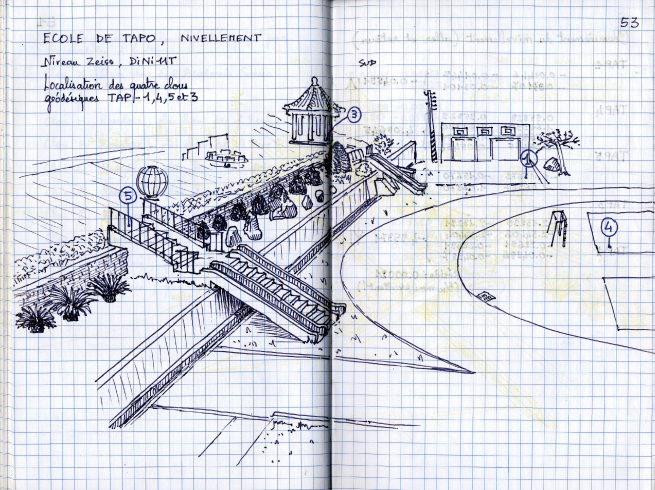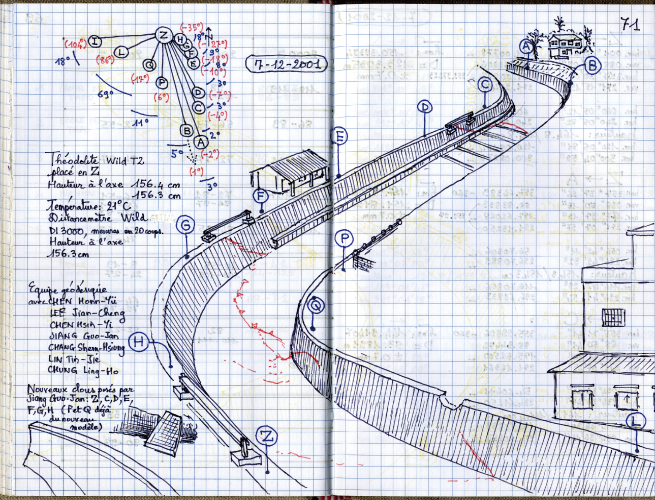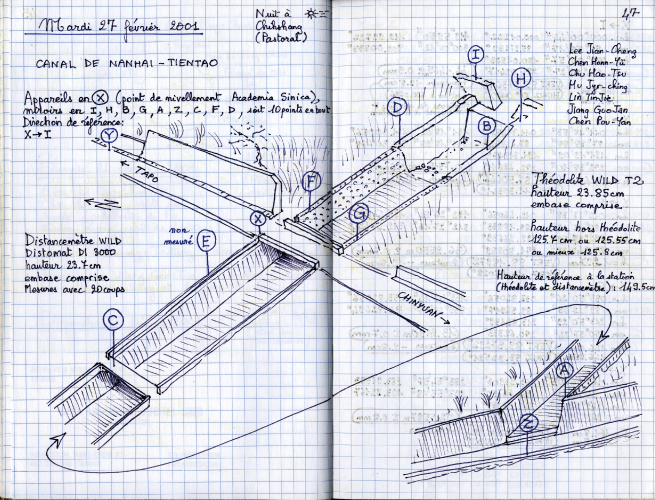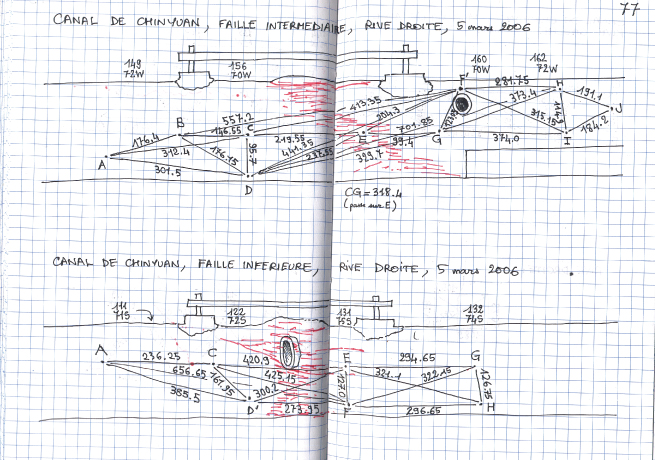|
三個年代
安朔葉教授在台灣地質工作的最後十年中,池上斷層成為一個重點研究項目。池上斷層地表破裂露頭的陸續發現及位移量測,是從90年代初開始的。到了90年代末,安教授與台灣學者共同設計製作了潛變儀,置於大坡國小及錦園溪溝渠兩個斷層露頭點;並在池上地區幾個地表斷層破裂地點(包括大坡國小、大坡牆、南海天道、錦園等),佈設了大地測量網,實施定期測量。斷層位移量測的初步成果,顯示池上斷層似乎有季節性的不同活動行為。安教授為了進一步驗證此季節性變化的可能,從2000年起,每年來池上兩次(春、秋各一次),詳細觀察紀錄池上斷層的位移變化。在他過世前,安教授在池上鄉也是頗有名氣;很多鄉民都知道有這麼一個對池上斷層非常熱情的法國人,每年都來看看斷層。 In his last ten years of work of Taiwan, Professor Angelier had paid particular attention on studying the Chihshang Fault. The study had begun with a series of discovery of surface breaks of the creeping Chihshang Fault and the associated displacement-measurements since early 90s. Collaborated with Taiwanese colleagues, creep meters have been installed at Tapo School and Chinyuan channel sites and several local dense geodetic networks have been deployed annually since late 90s. Speculated on possible seasonal variation of fault slip from preliminary results of earlier measurements, Angelier started to measure the displacements of the fault twice per year (spring and autumn) since early 2000s until his last trip in 2009. His bold figure with a typical foreigner would then become a famous image for the local Chihshang people. Many habitants expected to see him to visit their rural country each year to 'measure the fault'. 
大坡國小滑梯,池上(2001作)這幾年來,池上大坡國小斜坡的滑梯及一旁的潛變儀,已經成為池上斷層的重要地標。不僅池上觀光的遊客會到此現場來個知性之旅,台灣各級學校的校外教學會來這裡地質講解,在地球科學的國際會議上也看得到這個場景的照片。安教授的這張素描,非常生動的把大坡國小斷層、滑梯,及斜坡上的造景樹、涼亭等表現在圖上。 Tapo School, Chihshang (2001)Tapo elementary school has become a touristic spot for the Chihshang Fault, due to the 'famous slider' across the fault at the foot of the slope of a small hill. Tourists come here to see the 'fault slider". Students come here to look at the active faults explained by their teachers. Pictures of faults in Tapo School have been exposed in many international conferences worldwide. Angelier's sketch might provide us a gift to memorize his work in Tapo school. 
錦園溪溝渠全景,池上(2001)這是池上斷層另一個非常重要的地質觀測點。池上斷層出露地表,斷層跡穿越錦園村,在人工建物上造成許多破壞。安教授在1991年的調查,便發現錦園村中有幾處斷層活動的痕跡,特別是在錦園溪排水溝,可以清楚觀察到三段明顯的斷層破裂,隨後1998年在此位置佈設了密集的測量點位。2001年和台灣學者共同從事大地測量時,安教授在一旁將錦園溝渠測量網全景以透視法繪製此圖。 Chinyuan site and Chihshang Fault (2001)The Chinyuan site along the channel of the Chinyuan River is also an important observation site of the Chihshang Fault. Three fault-strands emerge onto surface to rupture the channel at a horizontal distance of about 100 m. During a geodetic survey in 2001, Angelier showed his super 3-D perspective vision and sketch skills to make this overview of the Chinyuan site. 
南海天道溝渠全景,池上(2001)這個大地測量網位於大坡國小和錦園之間,斷層出露造成排水溝渠的破裂。此點臨近一廟,名為南海天道堂。安教授一直對台灣的廟宇很有興趣,也很喜歡富有東方色彩的寺廟建築及裝飾。台灣鄉下隨處可見的土地公廟,雖然多半很不起眼,但是安教授總是注意到它的存在。這也難怪安教授會將此溝渠斷層破裂觀測點,以附近的廟宇命名:「南海天道站」。仔細看安教授的這張素描,可以發現光影的掌握極佳,陰影很逼真。 Geodetic Network at Nanhai site, Chihshang(2001)The Nanhai Tiandao site is an observation site for the Chihshang fault located between Tapo school and Chinyuan village. The fault runs sub-perpendicular to the cemented channel and caused ruptures in the channel. This site was monitored and measured since early 90s for about 20 years. Angelier called the site "Nanhai Tiandao", borrowed the name of a nearby Taoist temple, which always fascinated him with typical Asian decoration and style. 
斷層破裂釘網,錦園溝渠(2006)池上斷層進行著各種不同的測量方式。安教授最有創意的測量方法中,除了大坡國小的滑梯外,就是在破裂擋土牆(或河堤)上佈設鋼釘網,進行定期量測。這張安教授的素描圖,描繪了這個道理簡單、技術單純,但是卻非常有效率且不失精準的測量方式。安教授和他的台灣同伴們,一起在破裂的牆上釘了鋼釘涵蓋了破裂範圍,藉由測量鋼釘彼此間長度的變化,可以得到斷層的位移速率。 Surface ruptures on retaining wall, Chinyuan (2006)Professor Anglier draw this sketch during the measurements of nail networks on the retaining walls, which he conducted regularly (once or twice a year) for about 20 years along the Chihshang Fault. This simple measurement came from the innovative idea of Angelier, in an attempt to quantify the displacement of the surface breaks of the rapid creeping Chihshang Fault. Data from repeated measurements in several years show a rather robust result by this easy original technique. |


